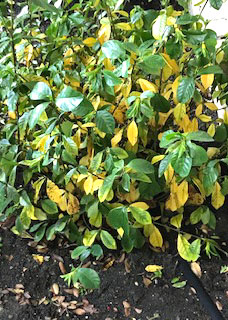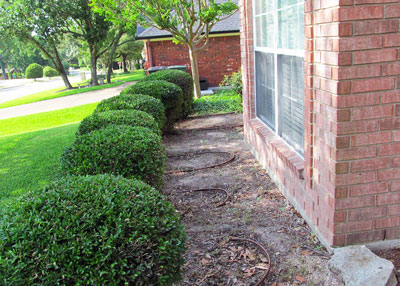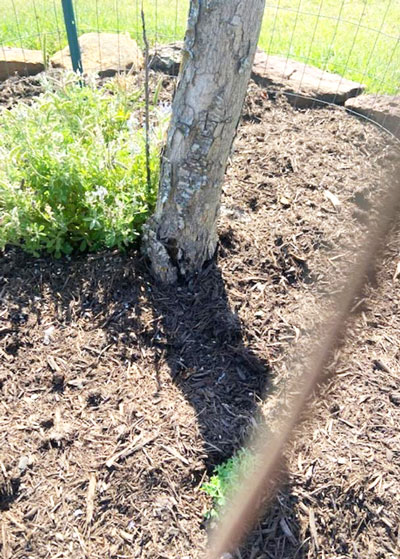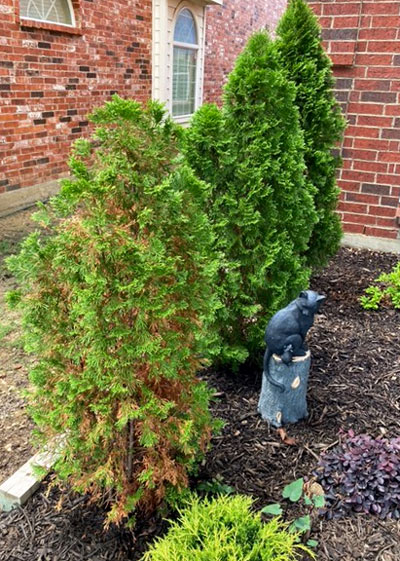Answers: May 26, 2022
Here are this week’s answers:
Question 1
GETTING CRAPE MYRTLES TO HOLD LEAVES
Question: How can I get my crape myrtles to hold onto their leaves longer into the fall so that they will have the lovely red color? N.J., Midlothian.
Answer: There is never any assurance of fall color in Texas, whether with crape myrtles or any other plants. However, you can improve your odds by keeping the plants watered properly in the fall and by protecting them against insects such as crape myrtle bark scale and crape myrtle aphids. Both of those pests secrete sticky honeydew. Sooty mold grows in the honeydew and will cause premature leaf drop.
Return to list of this week’s questions.
Question 2
GARDENIAS DROPPING LEAVES
Question: We bought two gardenia bushes for our front yard two months ago. Both are under the eaves of the house in the courtyard area. They get filtered sunlight. I have noticed that many leaves on both bushes are now yellow. Is this a water issue? Beverly G., Plano.

Answer: It certainly looks like it could be. It’s normal for older leaves (from last year) to turn yellow in late spring as new growth replaces them. However, the plant in your photo looks like it may also be somewhat wilted. Normally I would have suggested scratching around to see if soil feels dry, but Plano received a big rain just two nights ago. Hopefully the plants have perked up by now. Check the soil every few days. When it does feel dry, water it deeply. Hopefully you can turn them around.
Return to list of this week’s questions.
Question 3
ASHES OK IN GARDEN?
Question: I still have lots of oak ashes left over from the fireplace last winter. Would they be beneficial for my flowerbeds? Leann W., Garland.
Answer: In Garland, no. You have extremely alkaline soil and fireplace ashes are also highly alkaline. They would add insult to injury. The only place in Texas where ashes would be beneficial would be in acidic soils. That would be the eastern 20 percent of the state and isolated pockets elsewhere. You need to send them to the landfill.
Return to list of this week’s questions.
Question 4
GARDENIA DROPPING BUDS
Question: I can’t seem to make my gardenia happy. It’s in a container in a semi-shaded location. It keeps dropping buds before they open. I keep its soil moist but not wet. What might I be doing wrong? Ken A., Sulphur Springs.
Answer: I think I mentioned to a reader here a week or two ago the possibility of thrips in gardenias. They are the tiny insects that get into buds before they open and cause them to abort prematurely. Peel some of the buds open as you look for them. If you find whisker-shaped insects moving about within the buds you will need to apply a systemic insecticide such as Imidacloprid to stop them. Unfortunately, it will take that insecticide several weeks to become effective.
Return to list of this week’s questions.
Question 5
BEST REPLACEMENT PLANTS
Question: The freeze of 2021 took out a large holly hedge at the front wall. I’d like to replant there with pittrosporum or some other low-growing shrub. I’m going to take out the boxwood and replace it with annual color in front. Thoughts? Bob C., Temple.

Answer: I like the idea of annuals, although you’ll have to choose carefully since there is so much shade. You will need some low-growing shrubs beneath the windows. If it were my home, I might start by creating beds with long, sweeping curves across the entire front of my house. That would be much more natural and easier on the eyes. I would use clusters and groups of plants rather than rows. I think you’re talking about plants to grow beneath the windows to replace the hollies you have removed. I would still use hollies, but I’d stay with the shortest types, including dwarf yaupons, Carissas or dwarf Chinese hollies. You could also plant giant liriope as a tall groundcover in a cluster off to one side, but I would not have a long, straight row of any type of plant that that tried to repeat the lines of your house. How you lay out this bed must depend, to a large degree, on any bed on the other side of the front walk. They should not be mirror images of one another. That would look very restless. It’s difficult to do a landscape plan in this setting and seeing only half of the house. Let your nursery professional help you. I hope my ideas were useful. (By the way, dwarf pittosporum would be marginally winter-hardy most years in Temple.)
Return to list of this week’s questions.
Question 6
CHINQUAPIN OAK HAVING TROUBLES
Question: I planted a Chinquapin oak 7 years ago. Its leaves have now turned yellow and are falling off. The bark is flaking, and it is most pronounced just above the root flare. Another Chinquapin oak in my yard is doing just fine. What could be wrong? Dan U. Dripping Springs.

Answer: I cannot tell from the photo. However, the root flare does not appear to be exposed quite enough. It might be that this tree was planted slightly too low. I can’t see if the black mass at the base of the trunk is an old wrap to protect against sun scald or perhaps decay that has resulted from sun scald. I’m sorry to be vague. I just can’t see from the photo.
Return to list of this week’s questions.
Question 7
INSECTS ON LACEBARK ELMS
Question: My young lacebark elm looks bad. I shook a small twig of leaves over white paper and saw small insects moving around. My search of the insect identified thrips. I used a systemic drench of Imidacloprid on May 4. Teresa H., Tioga (Grayson Co.).
Answer: OK. However, I really wish I had a photo of the tree and a close-up of the leaves so I could see the symptoms myself. The main insect I’ve seen attack lacebark elms over the years has been lacebugs (common) and the most common disease has been cotton root rot (also frequent). That’s as close as I can come without a photo.
Return to list of this week’s questions.
Question 8
DWARF YAUPONS WITH DEAD SPOTS
Question: I have more than 30 dwarf yaupon hollies in my landscape. Several of them scattered in various parts of the yard have developed dead spots within the shrubs. The rest of the shrub will be OK. Any ideas? Tressa D., Levelland.
Answer: I’ve had the same thing happen with my own dwarf yaupons. I have never seen an insect or disease involved in any way. It’s generally been some kind of mechanical injury, for example a dog brushing against the plant and snapping a small branch, a ball landing in the plant or some type of storm damage. I would suggest clipping a few of the dead areas. Look closely at the interface areas to see if you can find anything wrong with the twig tissues that would give you a clue.
Return to list of this week’s questions.
Question 9
PECAN WEEVILS
Question: I have a pecan weevil problem, but with several large trees I can’t hope for effective spray coverage on more than the bottom half of the canopies. Is there a product I might use? Wayne H., Alvarado.
Answer: Pecan insects are certainly not my specialty, so I went to the Internet. My key words were “university” and “pecan weevils.” That gave me some really useful information and taught me how much I have to learn. I found these three fact sheets from Texas A&M, Oklahoma State and, on a homeowner basis, my friend Walter Reeves, now retired from the Georgia Extension Service, to be very helpful. I hope you find them to be as well.
From Texas A&M:
https://agrilifeextension.tamu.edu/wp-content/uploads/2017/10/controlling-the-pecan-weevil.pdf
From Oklahoma State:
https://extension.okstate.edu/fact-sheets/biology-and-control-of-the-pecan-weevil-in-oklahoma.html
From Walter Reeves, University of Georgia Extension Service:
https://www.walterreeves.com/food-gardening/pecan-weevil-control/
Return to list of this week’s questions.
Question 10
WHY DID PRIDE OF BARBADOS DIE?
Question: In 2020 and 2021 I attempted to grow Pride of Barbados. The plants became available in nurseries in August. Each year I purchased three plants and planted those six plants in six different locations. Why did they all die? Mike C., Southlake.
Answer: They froze. Those were two very bad winters. In fact, 2021 was a record-setter as you no doubt remember. Plus, by planting them so late in the growing season they hardly had a chance to get established. If you can find them in a nursery now you will have much better odds, especially if we have a mild winter next time around.
Return to list of this week’s questions.
Question 11
RABBITS IN GARDEN
Question: I have a large rural garden. We have a real problem with rabbits. Mothballs did not help. I’m ready to try bloodmeal, but I’m wondering if you have a better recommendation? Cindy D., Lucas.
Answer: The various repellents end up being of extremely limited value. If they work at all, they don’t work for very long. The first rain dilutes or eliminates their effectiveness. Fencing is generally considered to be the best means of preventing rabbit damage, but you have to be very careful not to leave even the smallest of gaps.
I thought I’d see if any of the ag schools had anything to add.
Here is something that Kansas State just posted a couple of weeks ago:
https://www.ksre.k-state.edu/news/stories/2022/05/horticulture-rabbits-in-the-garden.html
And the University of Florida:
https://gardeningsolutions.ifas.ufl.edu/design/gardening-with-wildlife/rabbits.html
Return to list of this week’s questions.
Question 12
EMERALD GREEN ARBORVITAE DYING
Question: What might be wrong with this Emerald Green arborvitae? Patricia K., Frisco.

Answer: I would be willing to bet that it’s loaded with spider mites. At a time when the twigs are dry, hold a sheet of white paper alongside and thump one of the branches against the paper. If you see tiny (almost microscopic) specks start to move, those are the mites. These newer types of arborvitae are highly susceptible and rarely do well in North Central Texas. I found out the hard way 10 or 12 years ago. Usually, the plants are lost within the first 12 to 18 months. They really don’t like our heat and low humidity. They really should not be sold in your part of Texas (in my opinion).
Return to list of this week’s questions.
Question 13
BOTTOM OF SWEET AUTUMN CLEMATIS LOOKS BAD
Question: My Japanese clematis is thriving on the top but it looks sick at the base. What is wrong and what should I do? Suzy A., Rockwall.
Answer: Many readers will know it as sweet autumn clematis, the fall bloomer. I have it in my landscape as well and have had it for probably 30 years. It’s very important that it be cut back to within 12 to 18 inches of the ground each winter. It is such a robust grower that it will come back vigorously. That gets rid of all of that unsightly stubble. I wouldn’t do that now unless it’s just so ugly that you can’t stand to look at it. But mark the calendar to do so late winter every year.
Return to list of this week’s questions.
Question 14
TEXAS ASH ISN’T FIRMLY ROOTED
Question: My beautiful 3-year-old Texas ash looks healthy, full and tall. However, the south wind almost pulls it up so I cannot take it loose from its stakes. I have just loosened them, per advice. Will it eventually become firmly rooted? Jwalk, Waxahachie-Maypearl.
Answer: I would not loosen the cables attached to the stakes. Allowing it to wobble will keep it loose. Hopefully it will get a firm set of roots and take off. It’s not a comment you want to see here, but I do need to warn you that ash trees are facing some very serious threats from the Emerald Ash Borer, a new insect that has recently moved into our part of America. It has devastated ash forests through the Midwest.
Return to list of this week’s questions.
Question 15
SAVING SEEDS FROM PRAIRIE VERBENAS
Question: How can I get seeds from a nice stand of prairie verbenas we have on our property? Reggie T., Hewitt.
Answer: I haven’t done so personally, but keep a very close eye on the plants as the stems mature. You should be able to tell when the seeds are starting to be distributed naturally. At that point you could slide a piece of cardboard in beneath a plant, thump the stems and collect the seeds that fall to the cardboard. Store them in a zipping sandwich bag in the butter bin of your refrigerator until September, at which point you can sow them into a new location.
Return to list of this week’s questions.
